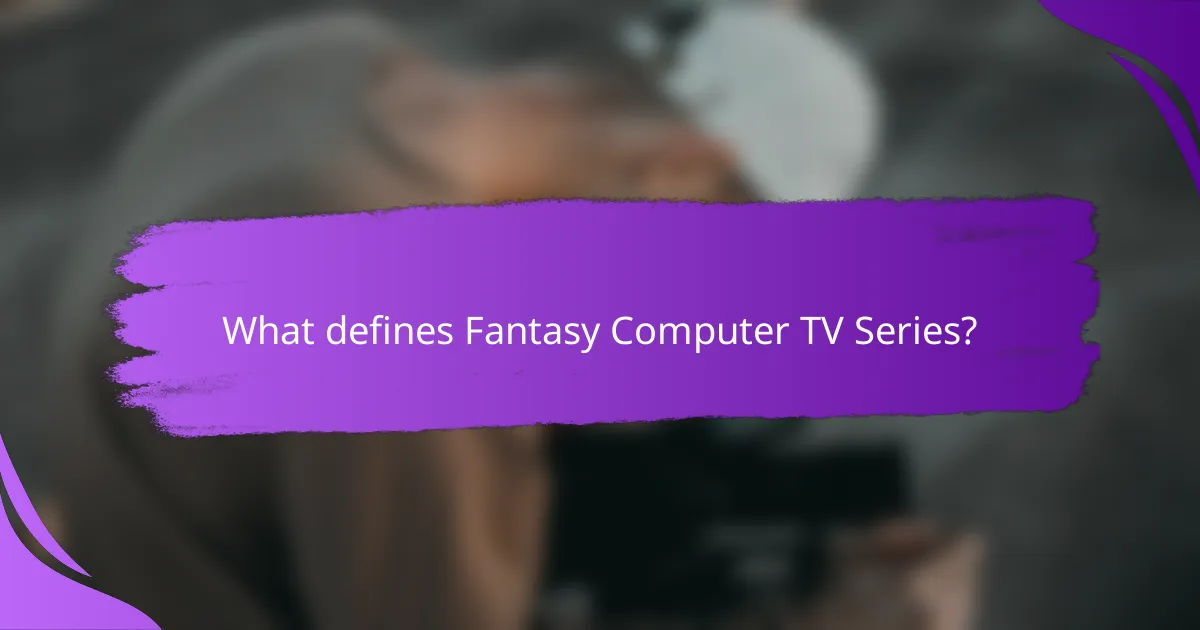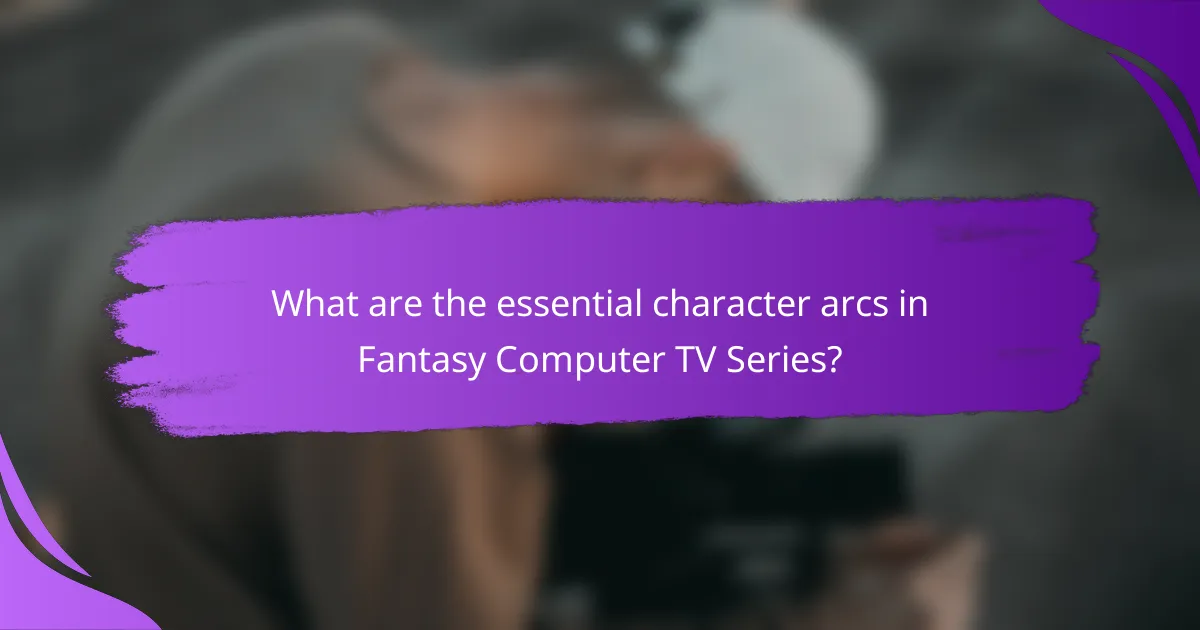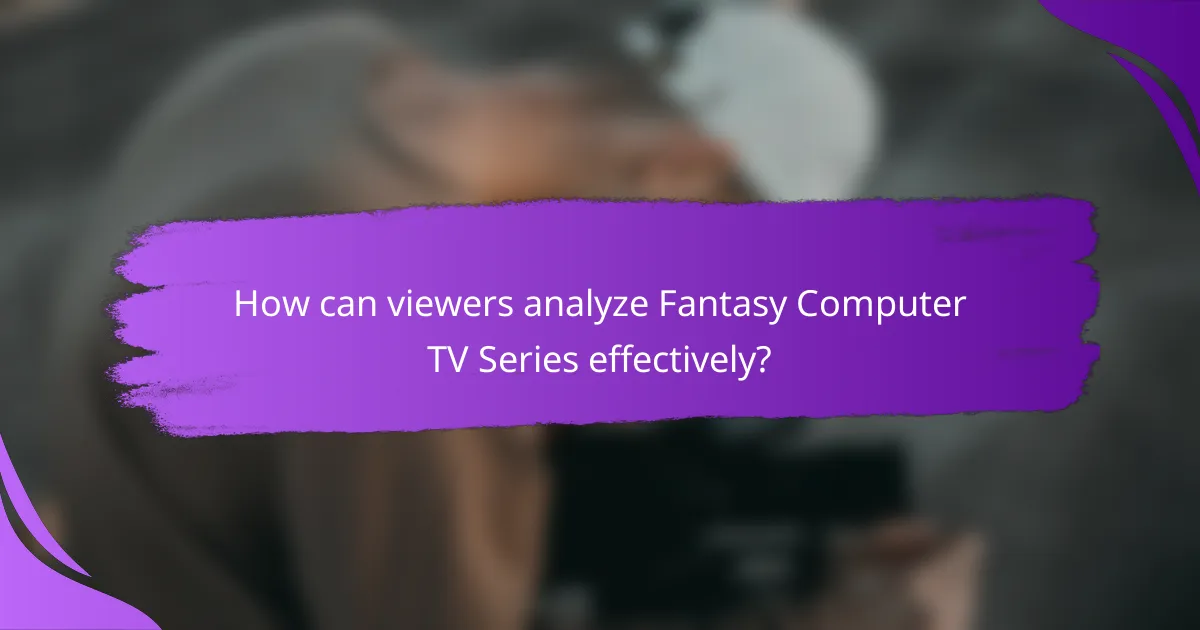Fantasy computer TV series are a genre that combines fantastical elements with digital or virtual contexts, exploring themes such as alternate realities, magical systems, and advanced technologies. These series are characterized by intricate world-building, complex character arcs, and rich mythology drawn from various cultural lore. Key character arcs include the hero’s journey, transformation, and redemption, which enhance narrative depth and viewer engagement. The article will analyze essential elements like world-building, character development, and thematic depth, while also providing strategies for viewers to deepen their understanding through analysis and engagement with fan theories.

What defines Fantasy Computer TV Series?
Fantasy computer TV series are defined by their integration of fantastical elements within a digital or virtual context. These series often explore alternate realities, magical systems, and advanced technologies. They typically feature world-building that creates immersive environments distinct from the real world. Character arcs are frequently complex, involving growth and transformation influenced by fantastical events. Mythology plays a significant role, often drawing from various cultural lore to enrich the narrative. Examples include series like “The Witcher” and “Westworld,” which blend fantasy with technology. These series engage viewers through visual effects and storytelling that challenge the boundaries of reality.
How do Fantasy Computer TV Series differ from other genres?
Fantasy computer TV series differ from other genres primarily through their emphasis on elaborate world-building and immersive mythology. These series often create intricate universes with unique rules, cultures, and histories. This contrasts with genres like drama or comedy, which typically focus more on realistic settings and character interactions.
Additionally, fantasy computer TV series frequently incorporate advanced technology or gaming elements, enhancing viewer engagement. This integration of technology distinguishes them from traditional fantasy or other genres.
Moreover, character arcs in these series often involve transformative journeys, influenced by magical or technological elements. This differs from the more straightforward character development seen in many other genres.
Overall, the combination of fantastical elements, technology, and complex narratives sets fantasy computer TV series apart from other television genres.
What are the key characteristics of Fantasy Computer TV Series?
Fantasy Computer TV Series are characterized by imaginative worlds, magical elements, and complex narratives. They often feature advanced technology intertwined with fantasy themes. Character development is significant, showcasing growth and transformation. These series typically include rich world-building, creating immersive settings. Mythological references and lore enhance the storytelling. Visual effects play a crucial role in bringing fantastical elements to life. Themes of adventure, conflict, and morality are prevalent throughout the plots. Overall, they blend technology with fantasy to create engaging narratives.
Why is the fantasy element crucial in these series?
The fantasy element is crucial in these series because it allows for imaginative storytelling and world-building. Fantasy creates unique settings that transport viewers to realms beyond reality. These worlds often have their own rules, cultures, and histories, enriching the narrative. This element enables complex character arcs that explore themes of heroism, morality, and identity. Additionally, fantasy elements can symbolize real-world issues in a metaphorical way. For example, series like “Game of Thrones” use fantasy to comment on power dynamics and human nature. The fantastical aspects engage audiences, fostering emotional connections to characters and their journeys. Overall, the fantasy element enhances the depth and appeal of the series.
What role does world-building play in Fantasy Computer TV Series?
World-building is essential in fantasy computer TV series as it creates immersive settings. It establishes the rules and logic of the fictional universe. This foundation allows viewers to understand the characters’ motivations and conflicts. Detailed world-building enhances storytelling by providing context for plot developments. It also fosters a sense of realism and believability within the fantasy genre. Series like “The Witcher” and “Game of Thrones” exemplify effective world-building. These shows utilize rich lore, geography, and culture to engage audiences. Ultimately, world-building deepens viewer investment in the narrative and characters.
How is a fictional world constructed in these series?
A fictional world in these series is constructed through detailed world-building techniques. These techniques include creating unique landscapes, cultures, and histories. Writers often establish rules governing magic or technology within the world. Character backgrounds and motivations are intertwined with the world’s lore. Consistency in these elements enhances immersion for the audience. Visual design further supports the world-building through costumes and settings. Dialogue reflects the culture and values of the fictional world. Overall, these components work together to create a believable and engaging environment for the story.
What elements contribute to immersive world-building?
Immersive world-building includes elements such as detailed settings, rich lore, and complex characters. Detailed settings create a vivid backdrop for the story. They often include geography, architecture, and climate. Rich lore provides historical context and cultural depth. This includes myths, legends, and societal norms. Complex characters enhance engagement through their development and relationships. Their motivations and conflicts add layers to the narrative. Additionally, consistent rules for magic or technology establish believability. These elements work together to create a cohesive and engaging experience for the audience.
How does mythology influence Fantasy Computer TV Series?
Mythology significantly influences Fantasy Computer TV Series by providing foundational narratives and archetypes. These series often draw on mythological themes to create rich, immersive worlds. Characters are frequently modeled after mythological figures, embodying traits like heroism or trickery. Plotlines may mirror ancient myths, exploring themes of good versus evil or the hero’s journey. For example, series like “The Witcher” incorporate Slavic folklore, enriching their storytelling. Mythological creatures and gods also populate these narratives, enhancing the fantastical elements. This incorporation of mythology deepens viewer engagement by resonating with familiar cultural stories. Overall, mythology serves as a crucial framework for developing characters and plots in these series.
What types of mythological elements are commonly used?
Commonly used mythological elements include gods, heroes, and mythical creatures. Gods often represent natural forces or human traits. Heroes typically embark on quests and face challenges. Mythical creatures, such as dragons and fairies, add intrigue and conflict. These elements create rich narratives and enhance world-building. They draw from various cultural mythologies, providing depth and relatability. For example, the hero’s journey is a prevalent narrative structure in many myths. This structure involves stages like the call to adventure and the return home. These elements contribute to storytelling in fantasy computer TV series.
How do mythological themes enhance storytelling?
Mythological themes enhance storytelling by providing universal archetypes and moral frameworks. These elements resonate with audiences across cultures. They create a deeper emotional connection to characters and plotlines. Mythology often introduces epic quests and transformative journeys. Such narratives engage viewers through relatable struggles and triumphs. Additionally, mythological themes enrich world-building by establishing historical context. They offer a sense of continuity and depth to the fictional universe. This connection can elevate the stakes of the story, making conflicts more compelling. Overall, mythological themes serve as a powerful tool in crafting immersive and memorable narratives.

What are the essential character arcs in Fantasy Computer TV Series?
Essential character arcs in Fantasy Computer TV Series include the hero’s journey, transformation, and redemption. The hero’s journey typically involves a protagonist facing challenges and evolving through their experiences. Transformation arcs showcase characters who undergo significant personal growth or change, often influenced by their environment or relationships. Redemption arcs focus on characters seeking forgiveness or atonement for past mistakes. These arcs contribute to character depth and audience engagement. Examples include protagonists who start as naive and become wise leaders. Such arcs resonate with viewers, enhancing the narrative’s emotional impact.
How do character arcs develop throughout a series?
Character arcs develop throughout a series by showcasing the transformation of characters over time. This transformation often involves changes in beliefs, motivations, and relationships. Characters face challenges that force them to confront their flaws. As they navigate these obstacles, they grow and evolve. The development is often marked by key events that trigger significant change. These events can include personal losses, victories, or moral dilemmas. Each season typically builds on previous character growth, creating a layered narrative. The culmination of a character arc usually aligns with the series’ overarching themes and resolutions.
What are common types of character arcs found in these series?
Common types of character arcs found in fantasy computer TV series include the hero’s journey, the tragic arc, and the redemption arc. The hero’s journey typically involves a protagonist who undergoes significant growth and transformation. This arc often features a call to adventure, challenges, and eventual triumph.
The tragic arc involves a character who faces downfall due to a flaw or external circumstances. This arc often leads to a poignant conclusion, emphasizing loss and consequences. The redemption arc focuses on a character seeking forgiveness and making amends for past mistakes. This journey often showcases personal growth and moral dilemmas.
These character arcs are prevalent in many series, illustrating diverse storytelling techniques and emotional depth.
Why are character transformations significant to the narrative?
Character transformations are significant to the narrative because they drive character development and plot progression. They showcase growth, conflict, and resolution within the story. These transformations often reflect the central themes and messages of the narrative. For instance, a hero’s journey typically involves overcoming personal flaws or external challenges. This evolution engages the audience and fosters emotional connections. Additionally, character transformations can symbolize broader societal changes or moral lessons. They provide a framework for exploring complex human experiences and relationships. Ultimately, they enhance the depth and richness of the narrative.
What techniques are used to create compelling characters?
Compelling characters are created using techniques such as deep backstory development, distinct personality traits, and clear motivations. Backstory provides context and depth, making characters relatable. Distinct personality traits help differentiate characters and make them memorable. Clear motivations drive character actions and decisions, enhancing engagement. Additionally, dynamic character arcs allow for growth and change, keeping the audience invested. Conflict and relationships with other characters further enrich their complexity. These techniques are essential in crafting characters that resonate with viewers and contribute to the narrative’s richness.
How do character backstories contribute to their arcs?
Character backstories significantly contribute to their arcs by providing context for their motivations and decisions. These backstories reveal past experiences that shape a character’s personality. They often explain a character’s strengths, weaknesses, and fears. Understanding a character’s history allows the audience to empathize with their journey. This connection enhances emotional investment in the character’s development. Furthermore, backstories can introduce conflicts that propel the arc forward. For example, unresolved traumas may influence a character’s choices throughout the story. Overall, backstories create a foundation for character growth and transformation.
What role do relationships play in character development?
Relationships are crucial in character development. They shape characters’ motivations, beliefs, and actions. Interactions with others reveal traits that may not surface in solitude. For example, friendships can foster loyalty and bravery. Conflicts can expose vulnerabilities and growth opportunities. Relationships also provide emotional stakes, making characters relatable. In fantasy series, these dynamics often drive plot progression. Studies show that character relationships enhance audience engagement and investment in the story.

How can viewers analyze Fantasy Computer TV Series effectively?
Viewers can analyze Fantasy Computer TV Series effectively by focusing on key elements such as world-building, character development, and thematic depth. World-building involves understanding the rules, cultures, and histories that shape the series. Character development requires observing character arcs and their motivations throughout the narrative. Thematic depth includes exploring underlying messages and moral dilemmas presented in the story.
Engaging with fan theories and discussions can enhance analysis. This provides diverse perspectives and interpretations. Taking notes while watching helps track important plot points and character interactions. Researching the source material, if applicable, can provide additional context.
Utilizing online resources and forums dedicated to the series can also enrich understanding. Analyzing production elements, such as cinematography and sound design, reveals how these choices impact storytelling. Overall, a multi-faceted approach improves comprehension and appreciation of the series.
What analytical frameworks can be applied to these series?
Narrative analysis frameworks can be applied to these series. These frameworks examine story structure, character development, and thematic elements. They help in understanding how narratives are constructed in fantasy settings. Structuralism can dissect plot mechanics and character arcs. Post-structuralism allows for interpretation of meaning beyond the text. Additionally, genre analysis can classify series based on conventions and audience expectations. Contextual analysis considers cultural and historical influences on series creation. These frameworks provide insight into the complexities of world-building and mythology in fantasy TV series.
How do themes and motifs enhance understanding of the series?
Themes and motifs enhance understanding of the series by providing deeper layers of meaning. They connect characters’ journeys to broader concepts like friendship, sacrifice, and power. These elements create a framework for viewers to interpret events and character actions. For example, recurring motifs such as light and darkness symbolize the struggle between good and evil. Themes often reflect societal issues, prompting viewers to engage critically with the narrative. This engagement fosters emotional investment, making the story more impactful. Additionally, well-defined themes can guide character development, creating arcs that resonate with audiences. Thus, themes and motifs are essential for enriching the viewing experience and comprehension of the series.
What questions should viewers ask while watching?
Viewers should ask questions that enhance their understanding of the narrative. They can inquire about the motivations of key characters. Understanding why a character acts a certain way can deepen engagement. Viewers might also consider how the world-building elements influence the plot. Questions about the rules of the fantasy world can clarify its logic. Additionally, viewers should reflect on the relationships between characters. Analyzing these connections can reveal underlying themes. Lastly, viewers can explore how mythology shapes the story’s direction. This can provide insight into the series’ larger messages.
What are some best practices for engaging with Fantasy Computer TV Series?
To engage effectively with Fantasy Computer TV Series, viewers should immerse themselves in the show’s lore. Understanding the world-building elements enhances appreciation for the narrative. Viewers can take notes on character arcs to track development and relationships. Participating in online discussions or fan forums fosters a deeper connection with the community. Watching with subtitles can aid in comprehending complex dialogue and terminology. Rewatching episodes helps catch details missed during the first viewing. Engaging with supplementary materials, such as behind-the-scenes content, provides additional insights. Following official social media accounts keeps fans updated on news and events related to the series.
How can viewers deepen their appreciation for the genre?
Viewers can deepen their appreciation for the fantasy genre by exploring its intricate world-building and mythology. Understanding the lore and history of the fictional universe enhances engagement. Analyzing character arcs reveals deeper emotional connections and motivations. Engaging with supplementary materials, such as books and interviews, provides additional context. Participating in fan discussions fosters a sense of community and shared insights. Watching behind-the-scenes content showcases the creative processes involved. Recognizing thematic elements and symbols enriches the viewing experience. Overall, active engagement with the genre leads to a more profound appreciation.
What resources are available for fans of Fantasy Computer TV Series?
Fans of Fantasy Computer TV Series can access various resources. Online forums provide community discussions and fan theories. Streaming platforms offer episodes and behind-the-scenes content. Social media groups share news and updates. Merchandise stores sell themed products and collectibles. Fan websites often host character guides and episode summaries. Podcasts discuss episodes and explore themes in-depth. Books related to the series expand on lore and world-building. These resources enhance the viewing experience and foster community engagement.
Fantasy computer TV series are defined by their integration of fantastical elements within digital contexts, featuring complex character arcs and immersive world-building. This article explores the key characteristics that differentiate these series from other genres, emphasizing the role of mythology and advanced technology in storytelling. It examines how world-building techniques create believable fictional universes and the significance of character transformations in narrative development. Additionally, the article provides insights on effective analysis and engagement with these series, including best practices and available resources for fans.